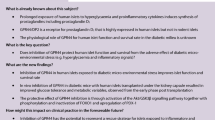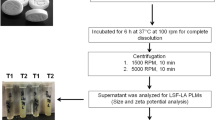ABSTRACT
Purpose
Our objective was to develop novel nanocarriers (protected graft copolymer, PGC) that improve the stability of heparin binding EGF (HBEGF) and gastrin and then to use PGC-formulated HBEGF (PGC-HBEGF) and Omeprazole (+/− PGC-gastrin) for normalizing fasting blood glucose (FBG) and improving islet function in diabetic mice.
Methods
HBEGF, PGC-HBEGF, Omeprazole, Omeprazole + PGC-HBEGF, Omeprazole + PGC-gastrin + PGC-HBEGF and epidermal growth factor (EGF) + gastrin were tested in multiple low dose streptozotocin diabetic mice.
Results
Omeprazole + PGC-HBEGF normalized FBG and is better than EGF + gastrin at improving islet function and decreasing insulitis. Groups treated with Omeprazole, Omeprazole + PGC-HBEGF, or EGF + gastrin have significantly improved islet function versus saline control. All animals that received PGC-HBEGF had significantly reduced islet insulitis versus saline control. Non-FBG was lower for Omeprazole + PGC-gastrin + PGC-HBEGF but Omeprazole + PGC-HBEGF alone showed better FBG and glucose tolerance.
Conclusions
Omeprazole + PGC-HBEGF provides a sustained exposure to both EGFRA and gastrin, improves islet function, and decreases insulitis in multiple low dose streptozotocin diabetic mice. Although HBEGF or EGF elevates non-FBG, it facilitates a reduction of insulitis and, in the presence of Omeprazole, provides normalization of FBG at the end of treatment. The study demonstrates Omeprazole and PGC-HBEGF is a viable treatment for diabetes.







Similar content being viewed by others
Abbreviations
- EGFRA:
-
Epidermal growth factor receptor agonist
- FBG:
-
Fasting blood glucose
- HBEGF:
-
Heparin-binding EGF
- Kd :
-
Dissociation constant
- non-FBG:
-
Non-fasting blood glucose
- PGC:
-
Protected graft copolymer
- T1D:
-
Type 1 diabetes
- T2D:
-
Type 2 diabetes
References
Brand SJ, Tagerud S, Lambert P, Magil SG, Tatarkiewicz K, Doiron K, et al. Pharmacological treatment of chronic diabetes by stimulating pancreatic beta-cell regeneration with systemic co-administration of EGF and gastrin. Pharmacol Toxicol. 2002;91(6):414–20.
Suarez-Pinzon WL, Yan Y, Power R, Brand SJ, Rabinovitch A. Combination therapy with epidermal growth factor and gastrin increases beta-cell mass and reverses hyperglycemia in diabetic NOD mice. Diabetes. 2005;54(9):2596–601.
Rooman I, Bouwens L. Combined gastrin and epidermal growth factor treatment induces islet regeneration and restores normoglycaemia in C57Bl6/J mice treated with alloxan. Diabetologia. 2004;47(2):259–65. Epub 2003/12/11.
Lev-Ran A, Hwang DL, Ben-Ezra J, Williams LE. Origin of urinary epidermal growth factor in humans: excretion of endogenous EGF and infused [131I]-human EGF and kidney histochemistry. Clin Exp Pharmacol Physiol. 1992;19(10):667–73. Epub 1992/10/01.
Feng J, Mehta VB, El-Assal ON, Wu D, Besner GE. Tissue distribution and plasma clearance of heparin-binding EGF-like growth factor (HB-EGF) in adult and newborn rats. Peptides. 2006;27(6):1589–96. Epub 2005/12/21.
Suarez-Pinzon WL, Power RF, Yan Y, Wasserfall C, Atkinson M, Rabinovitch A. Combination therapy with glucagon-like peptide-1 and gastrin restores normoglycemia in diabetic NOD mice. Diabetes. 2008;57(12):3281–8.
Mefford IN, Wade EU. Proton pump inhibitors as a treatment method for type II diabetes. Med Hypotheses. 2009;73(1):29–32. Epub 2009/03/24.
Castillo GM, Reichstetter S, Bolotin EM. Extending residence time and stability of peptides by Protected Graft Copolymer (PGC) excipient: GLP-1 example. Pharm Res. 2012;29(1):306–18. Epub 2011/08/11.
Zavros Y, Rieder G, Ferguson A, Samuelson LC, Merchant JL. Hypergastrinemia in response to gastric inflammation suppresses somatostatin. Am J Physiol Gastrointest Liver Physiol. 2002;282(1):G175–83. Epub 2001/12/26.
Castillo GM, Bolotin EM, Nishimoto-Ashfield A. Anionic-core composition for delivery of therapeutic agents, and methods of making and using the same. USPTO. 2012;App No 20120190097.
Bolotin E. Compositions for delivery of therapeutics and other materials, and methods of making and using the same (now patent#7,138,105). 2003;App No 20030224974.
Wang X, Mizushima H, Adachi S, Ohishi M, Iwamoto R, Mekada E. Cytoplasmic domain phosphorylation of heparin-binding EGF-like growth factor. Cell Struct Funct. 2006;31(1):15–27. Epub 2006/03/25.
Hieda M, Isokane M, Koizumi M, Higashi C, Tachibana T, Shudou M, et al. Membrane-anchored growth factor, HB-EGF, on the cell surface targeted to the inner nuclear membrane. J Cell Biol. 2008;180(4):763–9. Epub 2008/02/27.
Adam RM, Danciu T, McLellan DL, Borer JG, Lin J, Zurakowski D, et al. A nuclear form of the heparin-binding epidermal growth factor-like growth factor precursor is a feature of aggressive transitional cell carcinoma. Cancer Res. 2003;63(2):484–90. Epub 2003/01/25.
Reichstetter S, Castillo GM, Lai M, Nishimoto-Ashfield A, Banerjee A, Bogdanov A, et al. Protected Graft Copolymer (PGC) basal formulation of insulin as potentially safer alternative to Lantus(R) (Insulin-Glargine): a streptozotocin-induced, diabetic sprague dawley rats study. Pharm Res. 2012;29(4):1033–9. Epub 2011/12/29.
Reichstetter S, Castillo GM, Rubinsteinb I, Nishimoto-Ashfield A, Lai M, Jones CC, et al. Protected graft copolymer excipient leads to a higher acute maximum tolerated dose and extends residence time of vasoactive intestinal peptide significantly better than sterically stabilized micelles. Pharm Res. 2013;30:670–82.
Grau M, Tebar F, Ramirez I, Soley M. Epidermal growth factor administration decreases liver glycogen and causes mild hyperglycaemia in mice. Biochem J. 1996;315(Pt 1):289–93. Epub 1996/04/01.
Kozawa J, Tokui Y, Moriwaki M, Li M, Ohmoto H, Yuan M, et al. Regenerative and therapeutic effects of heparin-binding epidermal growth factor-like growth factor on diabetes by gene transduction through retrograde pancreatic duct injection of adenovirus vector. Pancreas. 2005;31(1):32–42. Epub 2005/06/22.
Cameron CM, Kostyo JL, Papkoff H. Nonmammalian growth hormones have diabetogenic and insulin-like activities. Endocrinology. 1985;116(4):1501–5. Epub 1985/04/01.
Zendehdel K, Nyren O, Ostenson CG, Adami HO, Ekbom A, Ye W. Cancer incidence in patients with type 1 diabetes mellitus: a population-based cohort study in Sweden. J Natl Cancer Inst. 2003;95(23):1797–800. Epub 2003/12/05.
Bateman DN, Colin-Jones D, Hartz S, Langman M, Logan RF, Mant J, et al. Mortality study of 18 000 patients treated with omeprazole. Gut. 2003;52(7):942–6.
Reddy S, Cheung CC, Chai RC, Rodrigues JA. Persistence of residual beta cells and islet autoimmunity during increasing duration of diabetes in NOD mice and experimental approaches toward reversing new-onset disease with bioactive peptides. Ann N Y Acad Sci. 2008;1150:171–6.
Li L, Seno M, Yamada H, Kojima I. Betacellulin improves glucose metabolism by promoting conversion of intraislet precursor cells to beta-cells in streptozotocin-treated mice. Am J Physiol Endocrinol Metab. 2003;285(3):E577–83. Epub 2003/08/06.
Rizzello M, Abbatini F, Casella G, Alessandri G, Fantini A, Leonetti F, et al. Early postoperative insulin-resistance changes after sleeve gastrectomy. Obes Surg. 2010;20(1):50–5. Epub 2009/11/17.
Spector D, Shikora S. Neuro-modulation and bariatric surgery for type 2 diabetes mellitus. Int J Clin Pract Suppl. 2010;166:53–8. Epub 2010/08/18.
Brand SJ. Prolonged efficacy of islet neogenesis therapy methods with a gastrin/CCK receptor ligand and an EGF receptor ligand composition in subjects with preexisting diabetes. USPTO. 2006;Pat No 6992060B2: .
Rooman I, Lardon J, Bouwens L. Gastrin stimulates beta-cell neogenesis and increases islet mass from transdifferentiated but not from normal exocrine pancreas tissue. Diabetes. 2002;51(3):686–90.
Song SY, Gannon M, Washington MK, Scoggins CR, Meszoely IM, Goldenring JR, et al. Expansion of Pdx1-expressing pancreatic epithelium and islet neogenesis in transgenic mice overexpressing transforming growth factor alpha. Gastroenterology. 1999;117(6):1416–26.
Wilson KJ, Gilmore JL, Foley J, Lemmon MA, Riese 2nd DJ. Functional selectivity of EGF family peptide growth factors: implications for cancer. Pharmacol Ther. 2009;122(1):1–8. Epub 2009/01/13.
Bonner-Weir S, Baxter LA, Schuppin GT, Smith FE. A second pathway for regeneration of adult exocrine and endocrine pancreas. A possible recapitulation of embryonic development. Diabetes. 1993;42(12):1715–20.
Gu D, Sarvetnick N. Epithelial cell proliferation and islet neogenesis in IFN-g transgenic mice. Development. 1993;118(1):33–46.
Vigneri P, Frasca F, Sciacca L, Pandini G, Vigneri R. Diabetes and cancer. Endocrine-Relat Cancer. 2009;16(4):1103–23. Epub 2009/07/22.
Singh P, Indaram A, Greenberg R, Visvalingam V, Bank S. Long term omeprazole therapy for reflux esophagitis:follow-up in serum gastrin levels, EC cell hyperplasia and neoplasia. World J Gastroenterol. 2000;6(6):789–92. Epub 2002/01/31.
Ligumsky M, Lysy J, Siguencia G, Friedlander Y. Effect of long-term, continuous versus alternate-day omeprazole therapy on serum gastrin in patients treated for reflux esophagitis. J Clin Gastroenterol. 2001;33(1):32–5.
Hyder A, Laue C, Schrezenmeir J. Effect of the immunosuppressive regime of Edmonton protocol on the long-term in vitro insulin secretion from islets of two different species and age categories. Toxicol In Vitro. 2005;19(4):541–6. Epub 2005/04/14.
Gangemi A, Salehi P, Hatipoglu B, Martellotto J, Barbaro B, Kuechle JB, et al. Islet transplantation for brittle type 1 diabetes: the UIC protocol. Am J Transplant. 2008;8(6):1250–61.
Lopez-Talavera JC, Garcia-Ocana A, Sipula I, Takane KK, Cozar-Castellano I, Stewart AF. Hepatocyte growth factor gene therapy for pancreatic islets in diabetes: reducing the minimal islet transplant mass required in a glucocorticoid-free rat model of allogeneic portal vein islet transplantation. Endocrinology. 2004;145(2):467–74. Epub 2003/10/11.
Akirav EM, Baquero MT, Opare-Addo LW, Akirav M, Galvan E, Kushner JA, et al. Glucose and inflammation control islet vascular density and {beta}-cell function in NOD mice: control of islet vasculature and vascular endothelial growth factor by glucose. Diabetes. 2011. Epub 2011/02/11.
Bogdanov Jr AA, Mazzanti M, Castillo G, Bolotin E. Protected Graft Copolymer (PGC) in imaging and therapy: a platform for the delivery of covalently and non-covalently bound drugs. Theranostics. 2012;2(6):553–76. Epub 2012/06/28.
Medarova Z, Castillo G, Dai G, Bolotin E, Bogdanov A, Moore A. Noninvasive magnetic resonance imaging of microvascular changes in type 1 diabetes. Diabetes. 2007;56(11):2677–82.
ACKNOWLEDGMENTS AND DISCLOSURES
This work was supported by the SBIR Grant # DK084724 from National Institute of Diabetes and Digestive and Kidney diseases of the National Institute of Health. There has been no prior publication of the present study.
G.M.C. conceived the approach, designed the experiments, researched data, and wrote the manuscript. A.N.A. contributed to the design of the experiments, researched data, and reviewed/edited the manuscript. A.A.B.. and J.L.L. researched data and reviewed/edited the manuscript. A.V.L. reviewed/edited the manuscript. E.M.B. contributed to the design of the experiments and reviewed/edited the manuscript. The authors thank Ms. Cynthia Jones for help with preparing the manuscript, and Mr. ManShun Lai and Dr. Sandra Reichstetter for technical assistance. G.M.C., A.N.A., C.C.J., M.S.L., S.R., and E.M.B. are employees of PharmaIN Corp.; A.A.B.., J.A.L., and A.V.L. are employees of the University of Illinois.
Author information
Authors and Affiliations
Corresponding author
Rights and permissions
About this article
Cite this article
Castillo, G.M., Nishimoto-Ashfield, A., Banerjee, A.A. et al. Omeprazole and PGC-Formulated Heparin Binding Epidermal Growth Factor Normalizes Fasting Blood Glucose and Suppresses Insulitis in Multiple Low Dose Streptozotocin Diabetes Model. Pharm Res 30, 2843–2854 (2013). https://doi.org/10.1007/s11095-013-1112-6
Received:
Accepted:
Published:
Issue Date:
DOI: https://doi.org/10.1007/s11095-013-1112-6




